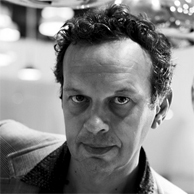Tom Dixon
designer (1959)
Tom Dixon was born in Sfax, Tunisia, in 1959, to a French-Latvian mother and an English father, who moved to England at the age of four and spent his school years in London.
After a childhood spent between Tunisia, Morocco, Egypt and Suez he moved to Huddersfield (northern England). He attends Holland Park an "educational experiment" school where he discovers the art department, the creation of ceramic artefacts and the transformative nature of design.
He attended the Chelsea School of Art for six months. Tom Dixon was the bassist of the band Funkapolitan in those years. In 1981 the band supported the Clash on their US tour and appeared on Top of the Pops.
The group achieved success in London, a recording contract and also participated, as a support group, in the tours of Simple Minds and Ziggy Marley.
In New York he saw the birth of the hip hop phenomenon, bought many records and began playing them in a club on Friday and Saturday evenings, having the other days free to dedicate himself to other things such as learning the welding technique from which he started a new business.
He doesn't know he's a designer but working in clubs he knows a lot of people, hairdressers, stylists, photographers, set designers who all need things. This is how it all started. From the beginning he created objects and sold things, combining the commercial aspect with the design one. He starts building objects "for fun" while organizing musical events for nightclubs. He becomes a full-time designer out of a passion for creating and making things.
Tom Dixon begins experimenting with welding techniques and product design. He became known as a designer in the mid-1980s with a line of "welded" furniture.
In 1987 he founded his own production company, Dixon PID, later "Space" with which he produced a series of multifunctional furniture and lighting in limited editions.
His Kitchen (1987) and S (1988) chairs are typical of his work from this period. In 1989 he exhibited his furniture and lamps at the Yves Gastou Galerie in Paris, attracting a lot of attention. Leading Italian brand Cappellini is the first to produce some of his furniture, including the famous S-chair, now in the permanent collection of MoMA in New York.
In the 1990s, he created "Jack", a polyethylene "seating, stacking and lighting object" designed for his company "Eurolounge".
In 1993 he participated in the "largest exhibition of British furniture design of the 20th century", organized by Helmut Diez in Bremerhaven, Germany.
In 1994 it produced and distributed its own collection under the name Eurolounge.
In 1997 he received the Millenium Mark award with the successful Jack lamp-chair, launched in 1996 by his own Eurolounge.
In 1998 Tom Dixon was appointed head of design at Habitat and subsequently became its creative director until 2008. He is the public face of a collective team responsible for rejuvenating the Habitat brand.
On this occasion he presents pieces by ten European designers over 70, born to be mass-produced and still relevant.
In 2002 he launched his own brand, Tom Dixon which includes a vast line of furniture and lighting objects.
In 2004 the company founded the Design Research group together with an investment fund, which also has the Finnish Artek in its portfolio. Dixon becomes artistic director of the brand founded by Alvar Aalto in 1935.
His works were exhibited at the British Council in Cologne and Beirut in the mid-1990s and are present in the collections of museums around the world, including the Victoria and Albert Museum in London, the MoMA (Museum of Modern Art) in New York and the Center Georges Pompidou in Paris.
Products:
Jack o illuminated seat/stool lamp, Eurolounge, UK, 1997.
Star table, floor or pendant lamp, Eurolounge, United Kingdom, 1997.
Melon table or floor lamp, Eurolounge, United Kingdom, 1998.
Block floor lamp, Eurolounge, United Kingdom, design 1998.
Mirrorball pendant lamps, draws inspiration from the famous space helmet and strobospheres. Mirror Ball is light and resistant, it reflects the surrounding environment and projects the ambient light downwards.










